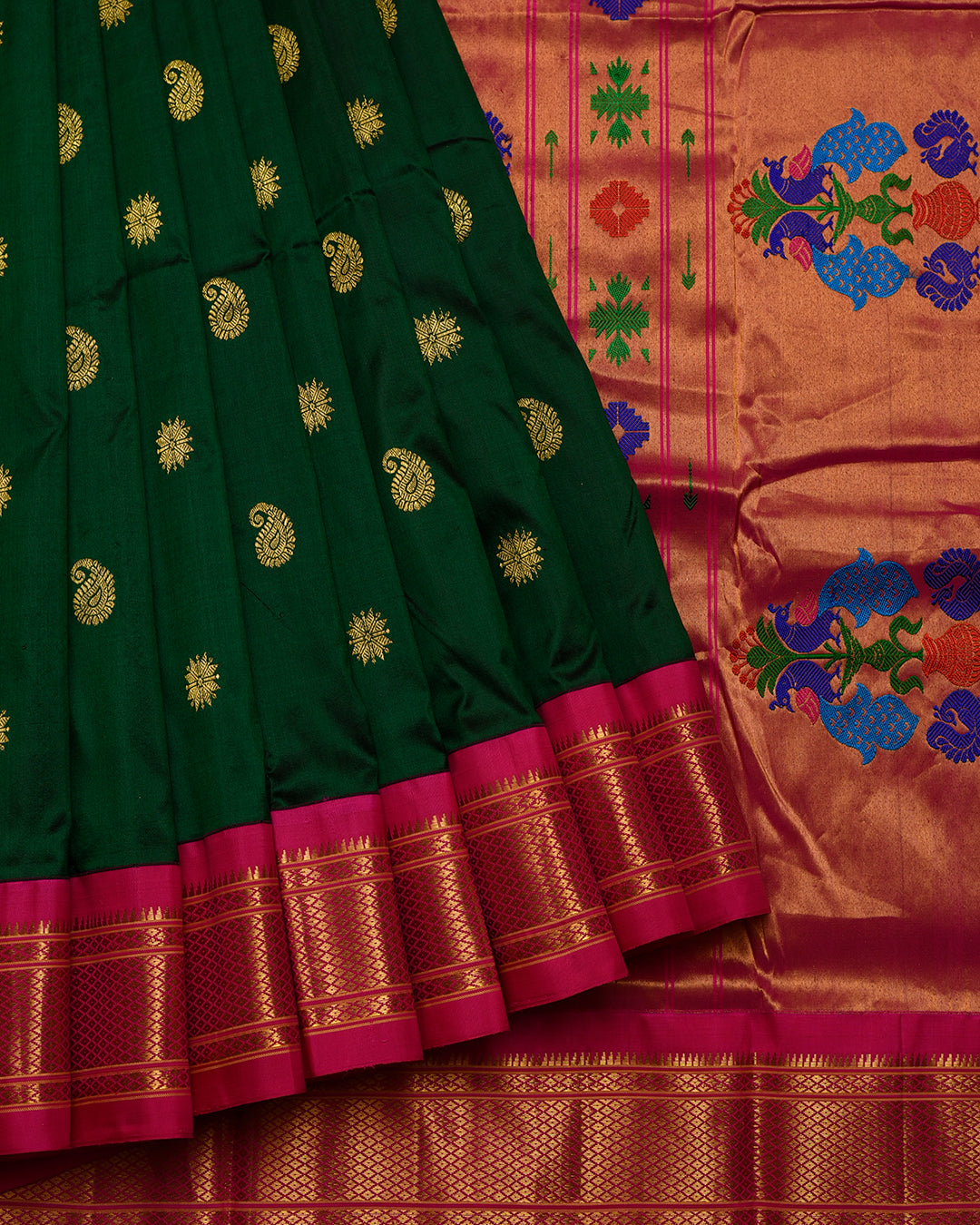The Role of Paithani Sarees in Maharashtrian Festivals

Paithani sarees are deeply intertwined with the cultural fabric of Maharashtra, symbolizing tradition, elegance, and heritage. These luxurious handwoven sarees are not just garments but a reflection of the state’s rich history and artistry. During Maharashtrian festivals, Paithani sarees take center stage, adding grace and grandeur to the celebrations. Here’s a look at the significant role Paithani sarees play in these joyous occasions.
1. Ganesh Chaturthi
-
Significance: Ganesh Chaturthi, dedicated to Lord Ganesha, is one of Maharashtra’s most celebrated festivals.
-
Paithani’s Role: Women often drape themselves in vibrant Paithani sarees to honor the auspiciousness of the occasion. The saree’s intricate motifs, like peacocks and lotuses, align beautifully with the spiritual essence of the festival.
-
Traditional Colors: Shades like bright yellow, green, and orange are particularly favored as they symbolize prosperity and positivity.
2. Makar Sankranti
-
Significance: This harvest festival marks the transition of the sun into Capricorn, celebrated with sweets, kites, and cultural gatherings.
-
Paithani’s Role: Black Paithani sarees, adorned with golden zari and colorful motifs, are traditionally worn on this day. The choice of black, considered inauspicious in other contexts, is symbolic of warmth and energy during winter.
-
Cultural Highlight: Women often accessorize their Paithanis with pearl jewelry and glass bangles, enhancing their festive look.
3. Gudi Padwa
-
Significance: Gudi Padwa marks the Maharashtrian New Year and the beginning of spring.
-
Paithani’s Role: Draping a Paithani saree is a customary way to celebrate this auspicious day. The saree’s vibrant colors and shimmering zari borders add a regal touch to the traditional rituals and processions.
-
Iconic Style: Many women choose the Kashta drape (nine-yard style) to pay homage to their cultural roots.
4. Diwali
-
Significance: Known as the festival of lights, Diwali is a time for family gatherings, prayers, and celebrations.
-
Paithani’s Role: During Diwali, Paithani sarees are worn to add elegance to the festive ambiance. The saree’s intricate weaving and luxurious silk perfectly complement the grandeur of the occasion.
-
Styling Tip: Women often pair their sarees with traditional gold jewelry and minimal makeup for a timeless look.
5. Weddings and Rituals
-
Significance: While not a festival, Maharashtrian weddings and rituals like haldi and griha pravesh are culturally significant celebrations.
-
Paithani’s Role: The saree is an integral part of a Maharashtrian bride’s trousseau. Brides typically wear a Paithani saree in hues of red, green, or yellow, symbolizing fertility, prosperity, and happiness.
-
Traditional Gift: Families often gift Paithani sarees to daughters or daughters-in-law, emphasizing its importance as a cultural heirloom.
6. Dussehra
-
Significance: Dussehra celebrates the victory of good over evil and is marked by prayers and cultural programs.
-
Paithani’s Role: On this day, women wear their best Paithanis to signify prosperity and devotion. The rich zari work and symbolic motifs reflect the festive spirit.
-
Motif Connection: The peacock and lotus motifs on Paithani sarees are seen as symbols of purity and divine beauty, aligning with the religious significance of Dussehra.
7. Bhai Dooj
-
Significance: This festival celebrates the bond between brothers and sisters.
-
Paithani’s Role: Sisters often choose lightweight Paithani sarees for the occasion, blending elegance with comfort.
-
Styling Tip: Pairing the saree with simple jewelry and a small bindi adds a touch of tradition.
Cultural Symbolism of Paithani in Festivals
-
Auspicious Colors: Paithani sarees in colors like green (fertility), yellow (prosperity), and red (auspiciousness) are particularly favored for festivals.
-
Heirloom Value: Passed down through generations, these sarees often hold sentimental and spiritual significance.
-
Showcasing Artistry: Wearing a Paithani saree during festivals is a way of honoring the artisans who keep this ancient craft alive.
